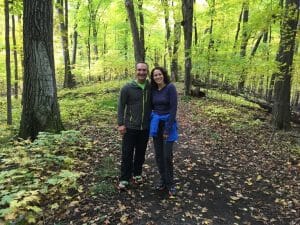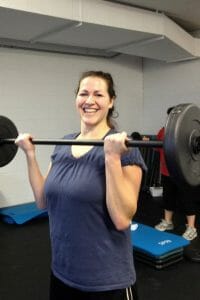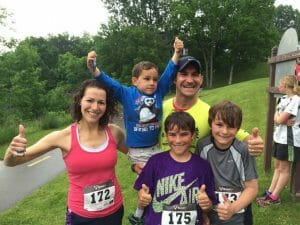All of us carry around some kind of self-imposed identity whether we’ve consciously identified it or not. Often times it is the obvious ones related to roles we are in:
Often times it is the obvious ones related to roles we are in:
- Our employment,
- Family relationships
- Hobbies
- Mother
- Father
- Accountant
- Football fan
- Runner
- Homeschooler
- Etc…
I cannot decide for you what your primary and secondary identities are going to be or even should be. However, let me flesh out my own primary identities and how it relates to prioritizing my life choices.
It goes without saying that your identities and priorities will be different than mine and naturally what I write below is not with the intention of getting you to change your identity to look like mine but to inspire you to analyze your own and see if you can re-work your choices to make healthier life choices leading to your joy and contentment!
My first identity is as a follower of Jesus Christ.
My belief identity stems from a love for God’s glory and my joy in knowing and serving Him through the salvation that comes by faith. This primary identity affects all the other “smaller” identities because I try to order all my priorities, plans, choices, etc based on the Bible and the outworking of my faith. This guides my sense of purpose and gives me the “bigger picture” perspective.
This identity has led me across the country and even temporarily across the globe and will be my primary identity for my entire future. This identity provides the framework for all the other secondary identities because if my choices and mindset of the secondary identities do not align with the primary, then those need to be reevaluated and changed. Primary identity always takes precedence over secondary identity when it comes to prioritizing my Christian faith and the choices related to following Jesus.
If a secondary identity like my “healthy living identity” starts to creep up and take precedence over my primary identity (i.e. a work-out on Sunday morning is more important than being in the house of God worshipping Him with other believers) then immediately it should be recognized as a problem and the identity choices re-aligned properly.
My next “big” identity is as a wife and mother.
Naturally, this affects who I spend time with, who I don’t spend time with, what I spend my money on, my sense of purpose, my vision for the next 20-30 years, and of course my social life is wrapped around my family.  My heart is entangled in this identity greatly because if my husband or boys succeed in something I rejoice for them, and if they are sorrowful, I am sorrowful with them.
My heart is entangled in this identity greatly because if my husband or boys succeed in something I rejoice for them, and if they are sorrowful, I am sorrowful with them.
One significant identity I’ve developed over the past 5 years is my sense of health and wellness. I actually identify as someone who is healthy, makes healthy choices, avoids unhealthy choices, spends time pursuing activities that I believe will lead to greater health, and as an athletic person who is fit enough to do whatever I can dream up (well, okay, I admit, there would need to be significant training to enact and realize a few athletic dreams I have in my head… but I digress).

I did not always have this identity, which only goes to show that miracles can happen! I used to identity as an unhealthy, out of shape, weak woman. Over time, however, I have slowly gained strength, fitness, and confidence to make choices for my health and fitness.
To have this healthy mindset and the realization that I am blessed enough to identify myself this way is a gift. I wonder if I was facing a terminal illness, a severe injury, if I was older, would I still identify myself this way? I believe the answer is yes.
You see, having an identity as a healthy person doesn’t mean you actually have to be 100% healthy. In fact, none of us are….that is why it is primarily in our mindset and attitudes that the real identity is made. You can “feel” healthy even when sick.
Recently I had Lyme’s disease (a tick-born illness) and I was running a fever of 104 degrees for a couple of days. Even though I certainly didn’t feel healthy at the time, I never lost my identity as a healthy person because it is now deeply engrained in me. I say in my seminars that wellness isn’t just the absence of sickness but the presence of health. Health is so much more that simply not being sick.
I have two friends right now who are struggling with cancer and on paper, they are not “healthy”. However, in many ways, they embody health more than the average person I know because of their tremendous healthy mindset and perspective. What I’m saying is, you can be healthy when physically your body is not. Health is in large part a mindset and carrying around this healthy living identity will impact your choices and habits.

My identity as a healthy person has led to the following habits:
1. I exercise every day. Outside, inside, in work, in play, in chores, in recreation. It doesn’t have to be anything structured or fancy to be considered exercise in my book. Move!
2. I eat some quantity of healthy food or beverages every day. Some days more than others – hello, I’m human too, okay!
3. I make plans every day to attempt to inspire and encourage someone in making healthy choices. Sorry if I’ve done this to you and you think I’m annoying. I promise I don’t mean to be!
4. Work hard to create habits that lead to health. Yes, that does mean leaving the party early sometimes so that I can get up early to go work out. Yes, that does mean that most times I say “no” to dessert (unless I really like it and it’s “worth it” to me), fried food and the like. And I always say “no” to the big ones like smoking, alcohol, and soda.
5. I find people to spend time with that encourage me in health. I financially support endeavors that lead to health for people that I cannot touch in my day to day life (supporting runners who run for clean water in villages in Africa, for example)
6. I financially support endeavors that lead to health for people that I cannot touch in my day to day life (supporting runners who run for clean water in villages in Africa, for example)
7. I cook healthy meals. No, not every single day, but it’s a regular part of my life. Yes, this takes planning and time. It’s worth it.
8. I avoid places where no healthy food is served.
9. I try new things all the time (food, beverages, exercise, activities, events, races, etc)
10. I take my kids with me to “healthy” things so that they can have fun too and hopefully grow up and want to do these things with my husband and me on a regular basis….by choice!
So whether your “healthy living” identity is primary or secondary or has very little influence right now on your choices, I encourage you to start making a few new habits. You probably at least brush your teeth daily and that is part of a healthy living identity so even if you have to build on that, do it!
All of these primary and secondary identities are tied into my daily choices.
Creating a new healthy living identity is huge when you have come to end of your rope of “good intentions,” such as:
- What happens when you just don’t feel like eating kale anymore and really just want to order a pizza?
- What happens when you just don’t feel like putting on the running shoes and instead want to watch a football game all afternoon?
- What happens when you are stressed and busy at work and you just don’t feel like sacrificing an hour of sleep to get up and exercise?
- What happens when you get sick or receive a terrible diagnosis from a doctor and you no longer think you’re healthy?
Your healthy living identity will provide a framework for choices. Choices, choices, choices. Our life is made up of them and always will be.
Make a choice today to form new habits, new goals, new identities. You will not regret it.
Amy Sotis
Owner, Luminaries Retreat
A Christian-based health, wellness, and fitness retreat in St Croix Falls, WI
www.luminariesretreat.com

Thank you! Your article is encouraging and a blessing.
Thank you so much for your kind words!
I’m in a continuous process of renewing my mind and you have reminded me to think healthy. That resonates with a scripture that comes to mind Proverbs 23:7 NKJV
‘For as he thinks in his heart, so is he.’ Really blessed by your perspective on living a victorious life. Sounds good to me as a guy who lives in Ireland. x
Dear Tom,
That is a great passage – thank you so much for sharing and for your encouragement.
Great article! I need to refocus on my primary identity in Christ. I have focused too long on dieting, my weight or what I going to eat when I am beinging. Thank you!
Thank you so much for sharing your encouragement Robyn! God bless you in your journey to make Him your primary identity!